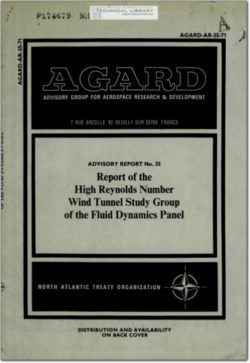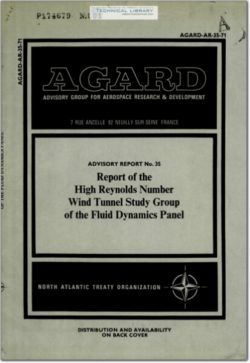AGARD-AR-35-71

- Version
- 212 Downloads
- 8.03 MB File Size
- 1 File Count
- March 8, 2016 Create Date
- March 8, 2016 Last Updated
Report of the High Reynolds Number Wind Tunnel Study Group of the Fluid Dynamics Panel

Modern aeronautical and aerospace systems are so expensive that every reasonable effort to minimize the risk
in their development is warranted. If a weapon system like the F—1 11 or an airplane like the Concorde suffers
delays or outright failure as a result of unforeseen technological problems, the penalties to the companies and
nations involved are staggering. The tried and proven way to minimize such risks on aerodynamic systems is to
conduct extensive tests in adequate wind tunnel facilities. Higher costs of the future, large sophisticated aeronautical
and aerospace systems make such testing even more imperative than is indicated by history.
Wind tunnels of the NATO countries have been shown, during recent years, to be quite inadequate for tests
for the large aeronautical systems under development. This fact was brought out by Dr Ki'ichemann at the 1968
AGARD Conference on Transonic Aerodynamics in Paris1 . The intricacies and inaccuracies associated with extra-
polation of wind tunnel data taken at a Reynolds number of 3 to 7 million for design of airfoils that operate at
Reynolds numbers of over 150 million were thoroughly discussed at the von Karman Institute’s lecture series on
“Large Airplane Aerodynamics” (Ref. 2). '
Mr J.L.Jones of NASA showed at the September 1969 meeting of the AGARD Fluid Dynamics Panel how
close the 0141 airplane had come to failure because of inadequate Reynolds number capability of existing transonic
wind tunnels3 . Recognizing the inadequacy of existing transonic wind tunnel capability, as'reflected in the above
mentioned references, and in view of the concern of several members of the Fluid Dynamics Panel, Dr W.R.Sears,
Chairman of the Panel wrote to the director of AGARD, Mr F.J.Ross, October 13, 1969, recommending the 'study
which is discussed in this report. Mr Ross’ affirmative response was immediate and work was begun by the AGARD
FDP High Reynolds Wind Tunnel working group in October 1969.
| File | Action |
|---|---|
| AGARD-AR-35-71 Report of the High Reynolds Number Wind Tunnel Study Group of the Fluid Dynamics Panel.pdf | Download |
Comment On This Post